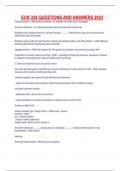UBCO EESC 101 Midterm 2 || Already Passed.
Arable correct answers land that is suitable for the annual planting of crops
Agriculture correct answers the practice of raising crops and livestock for human use and
consumption
Cropland correct answers land used to raise plants for human use
Rangeland correct answers land used for grazing livestock
Intensification correct answers The process of getting more in return for less; for example,
growing more food on a smaller plot of land.
cultivate correct answers raise and breed plants from seeds
domesticate correct answers tame animals as a source of both food and labor
traditional agriculture correct answers Biologically powered agriculture, in which human and
animal muscle power, along with hand tools and simple machines, perform the work of
cultivating, harvesting, storing, and distributing crops.
subsistence agriculture correct answers Self-sufficient agriculture that is small scale and low
technology and emphasizes food production for local consumption, not for trade.
food security correct answers the guarantee of an adequate and acceptable food supply to all
people at all times
industrialized agriculture correct answers Production of large quantities of crops and livestock
for domestic and foreign sale; involves use of large inputs of energy from fossil fuels (especially
oil and natural gas), water, fertilizer, and pesticides.
monoculture correct answers farming strategy in which large fields are planted with a single
crop, year after year
malnutrition correct answers a shortage of nutrients the body needs
Green Revolution correct answers enormous increases in agricultural productivity during the mid
to late twentieth century
Extensification correct answers increasing resource productivity by bringing more land into
production (as opposed to intensification, discussed previously, in which new technologies
permit greater resource productivity from each unit of land).
fertilizer correct answers a chemical or natural substance added to soil or land to increase its
fertility
,inorganic (industrial) fertilizers correct answers mined or synthetically manufactured mineral
supplements, mainly various combinations of nitrogen, phosphorus, and potassium.
organic fertilizer correct answers consist of natural materials, including animal manure; crop
residues; fresh vegetation (or "green manure"); and compost, a mixture produced when
decomposers break down organic matter, including food and crop waste, in a controlled
environment.
pesticides correct answers Chemicals used on plants that do not harm the plants, but kill pests
and have negative repercussions on other species who ingest the chemicals.
pest correct answers any organism that damages crops that are valuable to us
weed correct answers any plant that competes with crops
biological control correct answers the intentional release of a natural enemy to attack a pest
population
Integrated Pest Management (IPM) correct answers numerous techniques are integrated to
achieve long-term suppression of pests, including biocontrol, use
of chemicals, close monitoring of populations, habitat alteration, crop rotation, use of genetically
modified crops, alternative tillage methods, and mechanical pest removal.
pollination correct answers The transfer of pollen from male reproductive structures to female
reproductive structures in plants
genetic engineering correct answers any process whereby scientists directly manipulate an
organism's genetic material in the lab by adding, deleting, or changing segments of its DNA.
genetically modified organisms (GMO) correct answers an organism produced by copying genes
from a species with a desirable trait and inserting them into another species
transgenic correct answers term used to refer to an organism that contains genes from other
organisms
biotechnology correct answers A form of technology that uses living organisms, usually genes,
to modify products, to make or modify plants and animals, or to develop other microorganisms
for specific purposes.
seed banks correct answers institutions that preserve seed types as a kind of living museum of
genetic diversity
gene banks correct answers preserve genetic info and endangered plant species by storing their
seeds in refrigerated, low-humidity environments
, Feedlots correct answers Places where livestock are concentrated in a very small area and raised
on hormones and hearty grains that prepare them for slaughter at a much more rapid rate than
grazing; often referred to as factory farms.
aquaculture correct answers Raising marine and freshwater fish in ponds and underwater cages
sustainable agriculture correct answers farming and ranching that does not reduce the amount of
healthy soil, clean water, and genetic diversity essential to long-term crop and livestock
production
organic agriculture correct answers Approach to farming and ranching that avoids the use of
herbicides, pesticides, growth hormones, and other similar synthetic inputs.
Community Supported Agriculture (CSA) correct answers A system in which consumers pay
farmers in advance for a share of their yield, usually in the form of weekly deliveries of produce.
Biological diversity (biodiversity) correct answers the sum total of all organisms in an area,
taking into account the diversity of species, their genes, their populations, and their communities.
genetic diversity correct answers The range of genetic material present in a gene pool or
population of a species.
genetic bottleneck correct answers a limited variety of genetic material is available to be passed
along by the small number of surviving individuals to their descendants.
species diversity correct answers The number and relative abundance of species in a biological
community.
species richness correct answers the number of different species in a community
Eveness (Relative Abundance) correct answers the extent to which the population numbers of
individuals of each different species are equal or skewed.
ecosystem diversity (habitat diversity) correct answers variety of habitats, living communities,
and ecological processes in the living world
latitudinal gradient correct answers species richness increases toward the equator
extinction correct answers A term that typically describes a species that no longer has any known
living individuals.
extirpation correct answers The disappearance of a particular population from a given area, but
not the entire species globally
endangered correct answers A species whose numbers are so small that the species is at risk of
extinction





